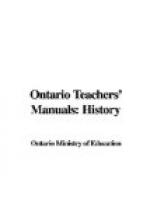(b) To acquaint the pupils with some of the important historical persons. We wish to take advantage of the fact that “the primitive form of attention which is captured at once by objects that strike the senses is giving place in some degree to appreciative attention, which is yielded to things that connect themselves with what we already know, and which implies ability to adopt the reflective attitude towards a proposed problem."[A] Now children are more interested in people than in institutions or events; and, if we can give them a knowledge of some of the striking incidents in the lives of important characters in history, we may expect them to be more interested in the study of history at a later period, because they will frequently meet with these familiar names. The emphasis at this stage is therefore on biography.
[Footnote A: Raymont: Principles of Education]
(c) To help the development of the “historical sense.” The “historical sense” includes the notion of time, the notion of a social unit and, according to some, the notion of cause and effect. The notion of time implies the power “to represent the past as if it were present”—that is, the power to enter into the thoughts and feelings of people of the past as if we were living amongst them. This notion of time comes at different ages; to some early, to others very late. It came to Professor Shaler at the age of about eight or nine years, as the direct result of vivid story-telling:
Of all the folk who were about me, the survivors of the Indian wars were the most interesting. There were several of these old clapper-clawed fellows still living, with their more or less apocryphal tales of adventures they had heard of or shared. There was current a tradition—I have seen it in print—that there had been a fight between the Indians and whites where the government barracks stood, and that two wounded whites had been left upon the ground, where they were not found by the savages. One of these had both arms broken, the other was similarly disabled as to his legs. It was told that they managed to subsist by combining their limited resources. The man with sound legs drove game up within range of the other cripple’s gun, and as the turkeys or rabbits fell, he kicked them within reach of his hands, and in like manner provided him with sticks for their fire. This legend, much elaborated in the telling, gave me, I believe at about my eighth year, my first sense of a historic past, and it led to much in the way of fanciful invention of like tales. (N.F. Shaler: Autobiography, Chap. I.)
The best means at the teacher’s command to assist its coming is to tell good stories from history with all the skill he has; the stories need not be told in chronological order. The notion of time implies also in the older pupils the power to place events in chronological order.
The notion of a social unit is also of slow growth and must spring from the child’s conception of the social units he belongs to—the home, the school, the community.




